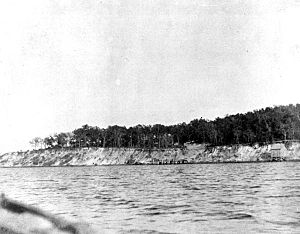Battle of St. Johns Bluff facts for kids
Quick facts for kids Battle of Saint John's Bluff |
|||||||
|---|---|---|---|---|---|---|---|
| Part of the American Civil War | |||||||
 St. Johns Bluff around 1900. |
|||||||
|
|||||||
| Belligerents | |||||||
| Commanders and leaders | |||||||
| John Milton Brannan | Charles F. Hopkins | ||||||
| Strength | |||||||
| 1,573 | 1 artillery battery 1 cavalry company |
||||||
| Casualties and losses | |||||||
| None | None | ||||||
The Battle of St. John's Bluff was an important fight during the American Civil War. It happened from October 1 to 3, 1862, in Duval County, Florida. In this battle, soldiers from the Union fought against forces from the Confederacy. The Union won, which helped them control the area around Jacksonville.
Contents
Why the Battle Happened
The St. Johns River was very important during the Civil War. If the Union controlled this river, they could easily move troops and supplies. They could also attack Confederate areas deeper inside Florida. The Union also wanted to control North Florida. This area could become a safe place for people seeking freedom. It would also help the Union start rebuilding Florida after the war.
Confederate Defenses
Early in the war, the Union Navy tried to sail ships up the St. Johns River. To stop them, Confederate General Joseph Finnegan built a strong defense. He placed an artillery battery (a group of cannons) on St. Johns Bluff. This bluff was about 18 miles downstream from Jacksonville, Florida.
Many Confederate soldiers had to leave Florida to fight in other battles. So, General Finnegan had fewer resources. Still, he managed to build strong defenses at St. Johns Bluff. Confederate troops used the help of enslaved people to build these forts. These defenses were part of a larger plan. Other forts were built nearby, like at Fort Caroline and Yellow Bluff Fort.
The Battle Begins
On September 11, 1862, Confederate cannons on the bluff fired. They shot at a Union gunboat called the USS Uncas. Another Union ship, the USS Patroon, joined the fight. Both ships fired back at the bluff. But they could not destroy the Confederate position.
The Union decided to send more than 800 soldiers from South Carolina. They expected the bluff to be a very tough challenge. Union reinforcements arrived on October 1 at Mayport Mills.
Union Attack
Brigadier General John Milton Brannan led the Union forces. He reported that on October 1, Union gunboats tried to scout the river. The Confederate batteries on St. John's Bluff immediately fired at them. The Union ships then pulled back.
The next day, Union soldiers under General Brannan tried a different approach. They marched toward the bluff from the rear. General Brannan later reported that a scouting party surprised a Confederate camp. They took some camp gear and about sixty weapons. The Confederate soldiers escaped because they had horses and knew the area well.
Confederate Retreat and Union Victory
Confederate Colonel Charles F. Hopkins was in charge of the bluff's defense. He reportedly became worried when Union troops approached from behind. Union gunboats were also firing on the bluff. Another Confederate officer, Captain Winston Stephens, thought they could still hold the position.
However, Colonel Hopkins decided to order a retreat. The Confederate forces left their position on October 2–3. Union troops then moved in and took control of the cannons left behind. Two days later, on October 5, the Union forces moved to nearby Yellow Bluff Fort. Confederate troops had also left that fort.
Aftermath of the Battle
The Union victory at St. John's Bluff was very important. On October 3, Union forces reoccupied Jacksonville. General Finnegan believed that Colonel Hopkins' decision to retreat was a big mistake. But Hopkins defended his choice.
After this battle, the Confederate threat in North Florida was much weaker. The Union could now control the St. Johns River and Jacksonville more easily.
Images for kids







